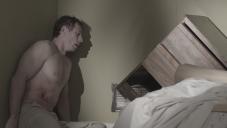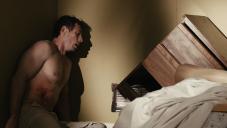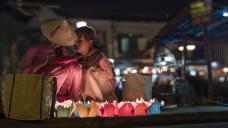
It allows to keep PV going, with more focus towards AI, but keeping be one of the few truly independent places.
-
@lunalobo75 Looks good to me man.
@Alfaerik Maybe so. I would say I'd go shoot some stuff really quick but I destroyed my Pocket Cam and it's on it's way in for an exchange. I'll try to dig up some old 3200K stuff. It shouldn't be that red.
-
@vicharris @Alfaerik Thanks, guys, for taking a gander. Beer time now after last nights edit crunch.
-
I've had similar problems getting the color back to something neutral/pleasing shooting BMPCC prores w/ daylight balanced Kinos in a studio.
No problems at all with the same setup filming with a GH2 instead.
And - oddly enough - also no problems whatsoever shooting the BMPCC in raw in the same setting. It's just prores that really struggles for some reason. I was able to grade it back for the most part, but it was not easy and the results were not what I would've preferred.
Not using any IR cut on the lenses, but I don't see how the other cameras/modes would be fine and prores would be a disaster. WB was set to 5000k, perhaps I could try a little warmer or cooler and see if it's any better.
Anyway, that's my experience.
-
If you're running into color issues, I'd likely try a few things (not saying any will work)
- 4500K to neutralize balance
- IR CUT (Hoya)
- 400 ISO (try to avoid 1600)
- Shoot RAW.
I've really never shot ProRes on the Pocket Camera, always RAW, so haven't seen that issue.
-
Yeah, I stick to RAW in that studio now. Or just shoot on the GH2, honestly, since it's talking head stuff for the web. Looks fine as-is.
-
Here man. Before/After. Most lighting at 3200K. Some small kickers at 5600k but not much at all. And this was actually before we had the Hoya IR cut filters available.

 1_1.10.1.jpg1080 x 608 - 89K
1_1.10.1.jpg1080 x 608 - 89K
 2_1.10.2.jpg1080 x 608 - 118K
2_1.10.2.jpg1080 x 608 - 118K -
@kholi why 400 ISO instead of 800?
-
@vicharris Great shot and killer grade. Shadow looks interesting. Seems like one hell of a scene too.
-
Thanks Matt. I actually didn't do too much to it. It was lit well. I used the Kodachrome LUT that was going around. I love that thing for a real film like look, dense and dirty.
-
@vicharris Perfect description. 1981 movie Body Heat came to mind - similar look. Yes, I've watched way too many movies.
-
Hi all thought you might be interested in a bit of a "Western" Look from "Down Under in this SLR MAGIC ANAMORPHOT 1,33 X - 50, the SLR Magic CINE II 35mm T1.4 lens Test (boy thats a mouthful!) on the Black Magic Pocket Cinema Camera (another mouthful)
-
Hey! I wonder if anyone has done extensive ISO tests (prores) on the bmpcc? I did a very quick and dirty one when I was supposed to shoot some s16 lens tests (though adapter failure put an end to my plans). What surprised me, was that the highs didn't seem affected at all by changing iso in camera. Latitude looked at it's peak at 800, 1600 just lifted (perhaps curved) blacks further, diminishing range a little bit and blacks were lowered at 400... Range diminishing quite a bit at 200.
Meanwhile I used the same aperture throughout the range, to preserve a similar amount of highlights. Mind, I haven't peaked on the footage under scopes, been way too busy yet to get to it.
I don't know, I haven't updated the firmware so it might be a firmware issue or a phenomenon subject to my particular camera.
Any in depth takes on this would be greatly appreciated.
-
In film mode, highs clip at the same point, regardless of ISO -- you'll just clip at, say, 80 or 90%, instead 100, if you use a value lower than 800. So there's really no sense in using 200 or 400, you just lose DR, by cramming the data into a smaller space -- although images can often be graded with less adjustment if they're shot at lower ISOs, which makes those settings preferable for some.
1600 will bring up the shadows, but at the expense of a stop at the highlights. That might be worth it, depending.
In RAW film mode, the ISO is changeable in post, so it's really just the way you're rating the meter. Some people use 400, as a way of automatically overexposing by a stop (or "exposing to the right", if you prefer).
-
@alfaerik I'm experiencing the same problem you are describing, only under household bulbs - those new, shitty EU energy saving bulbs. It is almost impossible to recover good colors. Everything has a strong pink reddish cast like your pictures show. My GH2 does not show this. Also RAW does not help, it's the same.
-
@RRRR somewhere I have read that the sensor is a dual gain sensor? This would explain different dynamic range at different ISO. In my experience, iso1600 further increases latitude, but at the expense of noise.
-
@jrd Makes sense and seems consistent with the tests.. Thanks!
-
@vicharris Your footage looks great. What project is it, looks promising. I wish I could have an resonable neutral starting point for grading, now it's just damage control.
@GMC Interesting to hear that you got the same problem. I find it strange that there's not more complaints about it. It must be a lot of other people who are using the bmpcc indoors with these kind of lamps, doing stuff when they have to rely on the exisiting light. Why isn't forums flooded with red damaged footage? I got an early copy of the camera, what about you? Could it be some kind of sensor calibration problem (I have no clue what I'm talking about, just guessing). Or could it be because of the bulbs are not full spectrum? But then again a lot of other people would have the same problem.
-
Footage looks good but the micro jitters are just way too bad. I know you wanted the handheld voyeur type stuff but better to use a shoulder rig and then add more movement in post. Also is my internet messed up or did you raise the SS there?
-
For the hell of it, I tried shooting with a cheap tungsten household bulb and a 3200K rated household CFL, with WB set at 3200K in both cases. The CFL is pretty dirty, but nothing like what you're seeing, no strong color cast. The tungsten was fine.
-
@vicharris I agree about the micro jitter and the shoulder rig and the clip/test would have been better , but I think its a pretty good demo of the set up stock hand held and just the Zacuto. The SLR Magic Anamorphot made the camera heavier by a bit and it felt more stable in the hand, but next time I will rig it up. Tell me what you mean by SS?
-
@jrd and @alfaerik, could it be related to the new European energy saving bulbs? I still have an old bulb in my cellar and although difficult to compare a quick look seemed to show alright colors. Also, I was recently in Vietnam and the nightshots were all very nice (a small sample below). And now that it was mentioned, the very first ProRes sample from Philip Bloom showing his cat also had this ugly pink / reddish cast. My BMPCC is from November 2013, but I have the latest firmware from a few weeks ago.

 Vietnam 2.jpg1920 x 1080 - 1M
Vietnam 2.jpg1920 x 1080 - 1M -
These new "bulbs" (actually tubes in a bulb) are awful and give ugly surprises with some sensors.
-
Here's a video I made using the BMPCC as a B-cam, matching with a Sony PMW-200 as the A-Cam for the interview. Graded to B&W. BMPCC was at 1600 ISO, bit grainy compared to the Sony, but in B&W it still remains a bit more cinematic and sharper.
-
@Alfaerik Here is my attempt to flat tiff. I made LUT for you to give a try.. you may apply it in FCPX by LUT Utility. Tell me how it goes. Thanks. https://www.dropbox.com/s/89cn9f8ighmemzl/ods-2.cube https://www.dropbox.com/s/vnnfzicsvuchcgq/ods-2.tif

 ods-2.png720 x 405 - 2M
ods-2.png720 x 405 - 2M -
On the tungsten v. daylight issue, Art Adams has some interesting thoughts at dvinfo.net, with reference largely to Red, but perhaps applicable here as well:
Years ago I shot a test with a Sony F35 and proved that silicon sensors are much more “balanced” under daylight than they are under tungsten light. I shot a test chart under both kinds of light and saw that under tungsten light, which contains lots of red and not much blue, the red channel was very clean and blue was very noisy, while under daylight the opposite was true: red was a little noisy and blue was very clean. It occurred to me that RED’s statement that the sensor was balanced for 5000K might have to do with noise. ...
There are some common differences that can be seen easily on a vectorscope, where colors containing red show a lot more “punch” under tungsten light while blues “pop” under daylight and HMI light, and this page at Arri’s website shows this effect fairly well visually. I’ve seen this effect on nearly every camera I’ve worked with. Most of the time the differences are very subtle, but they are generally present. They almost never make any creative difference at all (RED cameras, pre-Dragon, are the exception to this.)
http://www.dvinfo.net/article/optical-science/sensorcolorbalance.html
This may be a case where, under some conditions, there are "creative differences".
Howdy, Stranger!
It looks like you're new here. If you want to get involved, click one of these buttons!
Categories
- Topics List23,993
- Blog5,725
- General and News1,354
- Hacks and Patches1,153
- ↳ Top Settings33
- ↳ Beginners256
- ↳ Archives402
- ↳ Hacks News and Development56
- Cameras2,368
- ↳ Panasonic995
- ↳ Canon118
- ↳ Sony156
- ↳ Nikon96
- ↳ Pentax and Samsung70
- ↳ Olympus and Fujifilm102
- ↳ Compacts and Camcorders300
- ↳ Smartphones for video97
- ↳ Pro Video Cameras191
- ↳ BlackMagic and other raw cameras116
- Skill1,960
- ↳ Business and distribution66
- ↳ Preparation, scripts and legal38
- ↳ Art149
- ↳ Import, Convert, Exporting291
- ↳ Editors191
- ↳ Effects and stunts115
- ↳ Color grading197
- ↳ Sound and Music280
- ↳ Lighting96
- ↳ Software and storage tips266
- Gear5,420
- ↳ Filters, Adapters, Matte boxes344
- ↳ Lenses1,582
- ↳ Follow focus and gears93
- ↳ Sound499
- ↳ Lighting gear314
- ↳ Camera movement230
- ↳ Gimbals and copters302
- ↳ Rigs and related stuff273
- ↳ Power solutions83
- ↳ Monitors and viewfinders340
- ↳ Tripods and fluid heads139
- ↳ Storage286
- ↳ Computers and studio gear560
- ↳ VR and 3D248
- Showcase1,859
- Marketplace2,834
- Offtopic1,320








